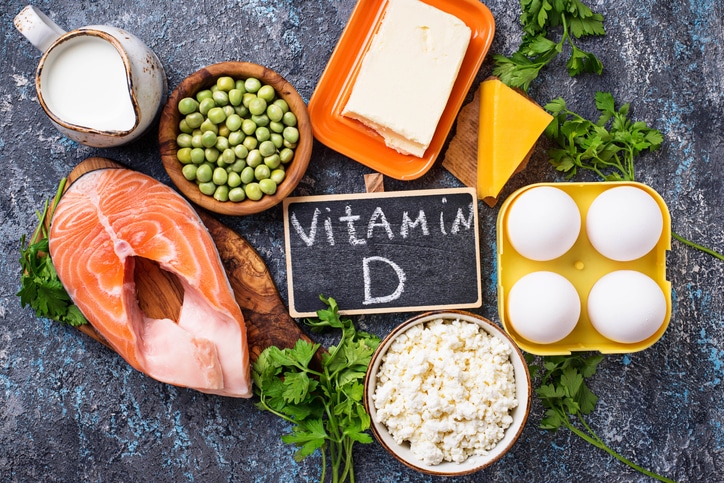
Written By: Director of Nutrition for Nava Health Laura Kelly, MA, MS, CNS, LDN
Low Vitamin D For Viral Infections?
Vitamin D is often called the “sunshine” vitamin because in the presence of sunlight, our bodies can make vitamin D3 (cholecalciferol). Vitamin D has many benefits and helps regulate a number of functions in the body including calcium homeostasis, blood pressure, immune function, cell production, insulin secretion, sex hormones and tissue remodeling. Recently, vitamin D has been a hot topic due to its immune modulating role in fighting viral infections such as SARS-CoV-2, the virus that causes COVID-19. So, let’s look at Low Vitamin D For Viral Infections.
Sources of Vitamin D & Low Vitamin D Supplementation
Unfortunately, most of us cannot synthesize enough vitamin D from the sun due to long hours spent inside and lack of sun exposure. This puts us at a disadvantage immunologically, especially in the winter months when we spend more time inside and the angle of the sun is slanted away from the earth. This means most people will need to obtain vitamin D from foods and/or supplements. Various food sources are either naturally high in vitamin D or they have been fortified with vitamin D2 (ergocalciferol). Over-the-counter vitamin D supplements will contain either vitamin D2 or vitamin D3.
Other Low Vitamin D Causes: Your Genetics
What most people do not know is that vitamin D obtained from sun exposure, food and supplements is actually biologically unusable. Once in your body, vitamin D must undergo two hydroxylations (adding an –OH group) to become activated. The first hydroxylation occurs in the liver where Vitamin D is converted to calcidiol [25(OH)D]. This is what is typically measured in blood work. The second hydroxylation occurs in the kidney and forms the active form, calcitriol [1,25(OH)2D]. A good way to remember this is D comes before T, so calciDiol (inactive) is converted to calciTriol (active).
How well your body converts calcidiol to calcitriol actually depends on your genetics. In fact, some individuals will over convert cacidiol to calcitriol causing low levels of calcidiol (remember this is what is measured on blood work) and high levels of calcitriol. This is why supplementing with high levels of vitamin D may not always raise serum vitamin D levels. This often means there is a rapid conversion of calcidiol into calcitriol. It may sound like a good thing to have higher levels of calcitriol, but like all things in the body, balance is essential!
How Vitamin D Affects the Immune System
Looking at the immune system, we see how this balance plays out. Calcitriol (the active form) activates enzymes that modulate B cells, T cells, dendritic cells, monocytes and natural killer cells. In fact, natural killer cells are a part of our innate immune system and have been found to be one of our first defenses against viral invasion, so we want these guys doing their job! Studies have also found that calcitriol regulates the pro-inflammatory chemicals that induce the inflammation responsible for injury to the lining of the lungs. This is also very good. However, if there is too much calcitriol, then immune cell receptors can become blocked, essentially deregulating immune function and causing adverse effects such as nausea, dizziness, fatigue, muscles weakness, tachycardia and autoimmunity. So, the moral of the story is: vitamin D levels need to be just right!
Balancing Your Vitamin D Levels
How do we make sure we are getting enough but not too much vitamin D? First, it is necessary to have optimal levels of vitamin A because vitamin D and vitamin A work synergistically. Essentially, vitamin A can help keep vitamin D in check. Generally, it is recommended to have a 2:1 ratio of vitamin A to vitamin D. That means if you are taking 2,000 IUs of vitamin D, you want to take 4,000 IUs of vitamin A. Remember to always take vitamins A and D with food as they are fat soluble vitamins and do need fat in order to be properly absorbed. It is also important to get outside. Morning light (before 10am) is less intense and provides good exposure without the risk of sun damage. Fortunately, spring is here and it is a great time to get out for an early walk, run, bike ride or simply take your coffee outside and sit in the morning light!
* If you have questions about specific dosing or other preventatives, please give us a call and we can set up an appointment with one of our nutritionists. We are here to help!
Vitamin D Foods
- Salmon
- Sardines
- Tuna
- Eggs
- Mushrooms
Vitamin D Rich Recipes
Salmon and Mushroom Bowl
Ingredients:
- One 1 1/2-pound salmon fillet, or two 12-ounce fillets
- 2 tablespoons extra virgin olive, plus about 1 teaspoon for the baking sheet
- Salt and freshly ground pepper
- 1 pound white or cremini mushrooms, rinsed briefly and wiped dry
- 2 shallots, minced
- 2 to 4 garlic cloves (to taste), minced
- 2 teaspoons chopped fresh thyme or rosemary (or a combination), or 1/2 to 1 teaspoon dried
- ¼ cup dry white wine, such as Sauvignon blanc
- Optional: ½ cup brown rice or sautéed cauliflower rice
Directions
1. Preheat the oven to 300ºF. Cover a baking sheet with foil and lightly oil the foil. Place the salmon on top. Season with salt and pepper. Fill a roasting pan with boiling water and place it on the oven floor.
2. Place the salmon in the oven and bake until the fish flakes and white bubbles of protein appear on the surface, 10 to 20 minutes, depending on the size of the fillets. Remove from the heat.
3. Meanwhile, cook the mushrooms. Heat a large, heavy frying pan over medium-high heat and add 1 tablespoon of the olive oil. When the oil is hot, add the mushrooms and cook, stirring or tossing in the pan, for a few minutes, until they begin to soften and sweat. Add the remaining oil, turn the heat to medium, and add the shallots, garlic, and herbs. Stir together, add 1/2 teaspoon salt and freshly ground pepper to taste, and cook, stirring often, for another 1 to 2 minutes, until the shallots and garlic have softened and the mixture is fragrant. Add the wine and cook, stirring often and scraping the bottom of the pan, until the wine has just about evaporated. Taste and adjust seasonings. Remove from the heat.
4. Serve the salmon over the brown rice or cauliflower rice with a spoonful of mushrooms on top or on the side. Enjoy!
Vitamin D Articles and Resources
1. https://www.mdpi.com/2072-6643/12/4/988/htm
2. https://www.ncbi.nlm.nih.gov/pmc/articles/PMC3100890/
3. Sundar, I. and Rahman, I. (2011) Vitamin D and susceptibility of chronic lung diseases: Role of epigenetics. Frontiers in Pharmacology. 2(50): 1-10.
4. Comprehensive Association Analysis of the Vitamin D Pathway Genes, VDR, CYP27B1, and CYP24A1, in Prostate Cancer Crystal N. Holick, Janet L. Stanford, Erika M. Kwon, Elaine A. Ostrander, Sergey Nejentsev and Ulrike Peters
5. Neurochem Int. 2016 Jan;92:49-57. doi: 10.1016/j.neuint.2015.12.005. Epub 2015 Dec 17.
6. Aranow, C. (2011). Vitamin D and the Immune System. Journal of Investigative Medicine : The Official Publication of the American Federation for Clinical Research, 59(6), 881–886. https://doi.org/10.231/JIM.0b013e31821b8755
7. Resource for TH17: https://www.ebioscience.com/knowledge-center/antigen/cytokines/th17-cells.htm

A Medical Director, and one of the first physicians to join the Nava Health & Vitality Center, Dr. Douglas Lord has made significant contributions to our Center and its founding principles. Dr. Lord has helped develop and implement the Nava Method™—Nava’s proprietary approach to total body wellness. He has also been instrumental in liaising with other expert practitioners to successfully implement Nava’s range of therapies, treatments, and products.